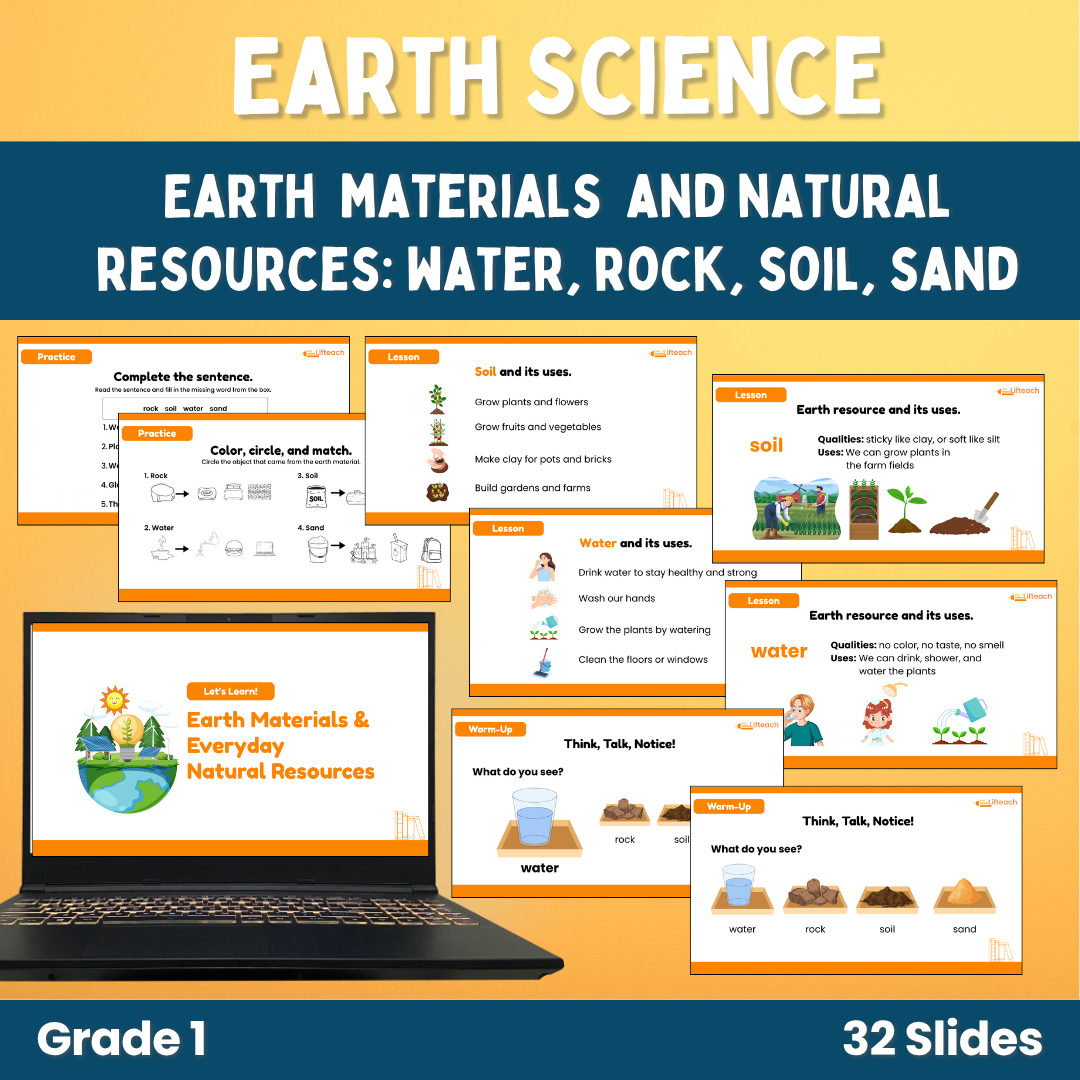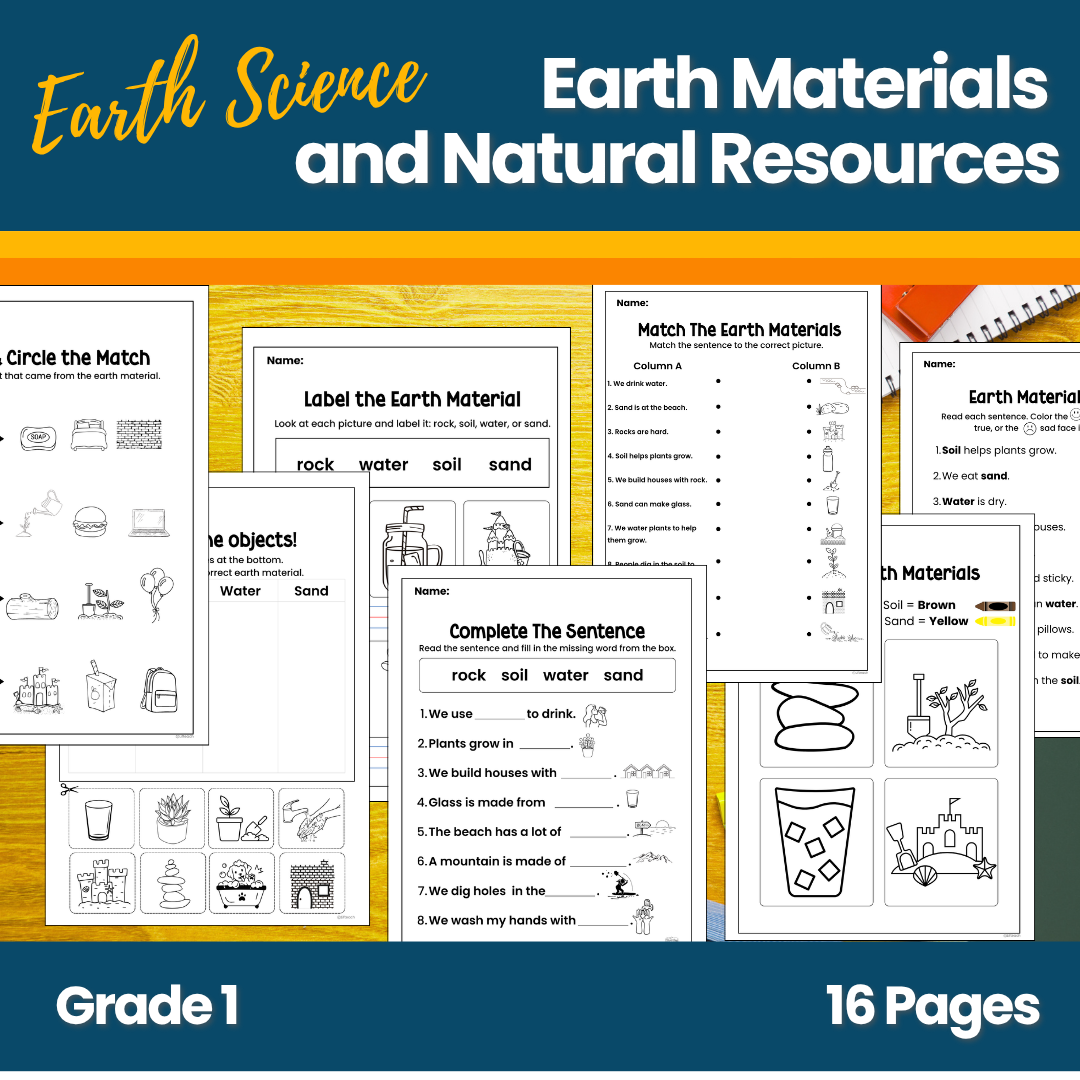Lesson Plan: Earth Materials & Everyday Natural Resources
Grade Level: Grade 1
Subject: Earth Science
Duration: 50 minutes
1. Learning Objectives
By the end of this lesson, students will be able to
- Identify and describe common Earth materials (rock, soil, water, and sand).
- Explain at least two ways humans use these Earth materials in everyday life.
- Ask and answer questions about the properties and uses of natural resources.
- Convey information in drawings and simple sentences.
2. Standards Alignment
Next Generation Science Standards (NGSS)
- 1-ESS2-1: Use observations to describe patterns in the natural world (Earth materials).
- K-ESS3-1: Use a model to represent the relationship between natural resources and human needs.
Common Core State Standards (CCSS)—ELA Connections
- RI.1.1: Ask and answer questions about key details in informational texts.
- RI.1.3: Describe the connection between two individuals, events, or ideas.
- SL.1.1: Participate in collaborative conversations with peers and adults.
- W.1.2: Write informative/explanatory texts in which they name a topic and supply some facts.
3. Materials & Resources
- Real or pictured samples of rock, soil, water, sand
- Chart paper & markers
- Pencils, crayons, glue sticks
- Magnifying glasses (optional)
- Picture cards illustrating uses (brick house, paper, glass jar, garden)
4. Lesson Procedures
A. Warm-Up/Introduction (5 min)
- Gather students on the carpet with four sample trays labeled Rock, Soil, Water, and Sand.
- Show them a video of “Natural Resources of the Earth.”
- Think-Pair-Share: “What do you notice about each tray? How are they the same or different?”
- Briefly record answers on chart paper under the headings Hard/Soft, Wet/Dry, and Rough/Smooth.
B. Lesson Proper (15 min)
- Small Discussion (5 min): Explain the qualities each material has and provide one sentence that describes it.
Earth Materials: rock, soil, water, and sand. Show picture cards or PowerPoint presentations.
C. Guided Discussion (10 min):
- “How do we use rock? Soil? Water? Sand?”
- Record student ideas on a chart (e.g., rock → building; soil → growing plants; water → drinking; sand → making glass).
- Model asking and answering questions: “Why do we use soil to grow plants?”
D. Guided Practice / Activities (10 min)
Choose from the following worksheets:
Worksheet 1: Color, circle, and match the earth materials.
Worksheet 2: Cut and paste the objects to the earth materials.
Worksheet 3: Complete the sentence.
E. Test/Assessments (10 min)
Choose from the following worksheets:
Worksheet 1: Sort & Match Earth Materials and Uses.
Worksheet 2: Color the smiling face for true and a sad face for false after reading the sentence.
- Students work independently; teachers offer help as needed.
F. Review & Closing (5 min)
- Exit Ticket: On a sticky note, each student writes/draws one way they use a natural resource at home.
- Share several examples aloud.
- Revisit the chart: reinforce key vocabulary and uses.
5. Assessment Methods
- Observation of Think-Pair-Share and chart contributions
- Completion & accuracy of Guided Practice Worksheets
- Performance on Assessment Worksheets
- Exit Ticket responses for real-world connections
6. Lesson Timeline
| Time | Activity |
| 0–5 min | Warm-Up/Introduction |
| 5–20 min | Lesson Proper (Direct Instruction + Q&A) |
| 20–30 min | Guided Practice (Worksheet 1) |
| 30–45 min | Assessment (Worksheet 2) |
| 45–50 min | Review & Exit Ticket |
7. Differentiation Strategies
- Struggling Learners:
Provide picture-word cards for matching.
Pair with a buddy for paired reading of instructions.
- English Learners:
Pre-teach key vocabulary with visual support.
Use sentence frames: “We use ___ to ___.”
- Advanced Learners:
Challenge to list an additional use of each material.
Journal prompt: “How might Earth materials change in the future?”


